Negotiation Strategies and Thinking Styles Report MBA506
VerifiedAdded on 2022/09/14
|9
|2438
|19
Report
AI Summary
This report presents an analysis of a negotiation scenario involving the sale of a commercial property. The student explores their thinking style (anarchic) and its suitability for negotiation, considering adjustments for optimal performance. The report identifies the client's and the other party's BATNA (Best Alternative To a Negotiated Agreement) and reservation values, calculating the ZOPA (Zone of Possible Agreement). It details the negotiation process, including the initial offer, counteroffers, and the influence of a competing potential buyer. The report concludes with a summary of the negotiation, highlighting key strategies and outcomes, and includes references to relevant sources. The assignment focuses on applying negotiation principles, understanding the dynamics of a commercial transaction, and analyzing the impact of various factors on the negotiation's success.
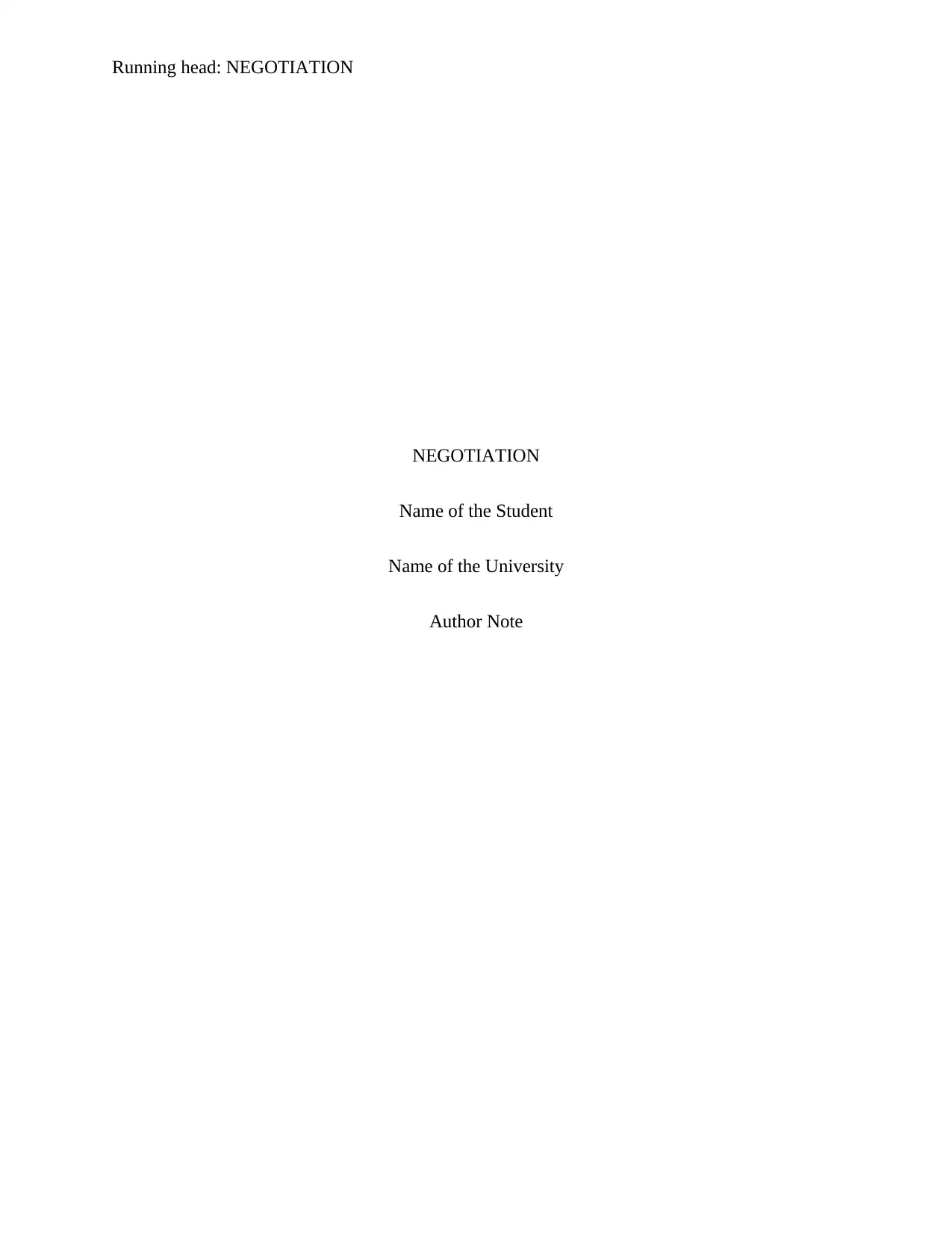
Running head: NEGOTIATION
NEGOTIATION
Name of the Student
Name of the University
Author Note
NEGOTIATION
Name of the Student
Name of the University
Author Note
Paraphrase This Document
Need a fresh take? Get an instant paraphrase of this document with our AI Paraphraser
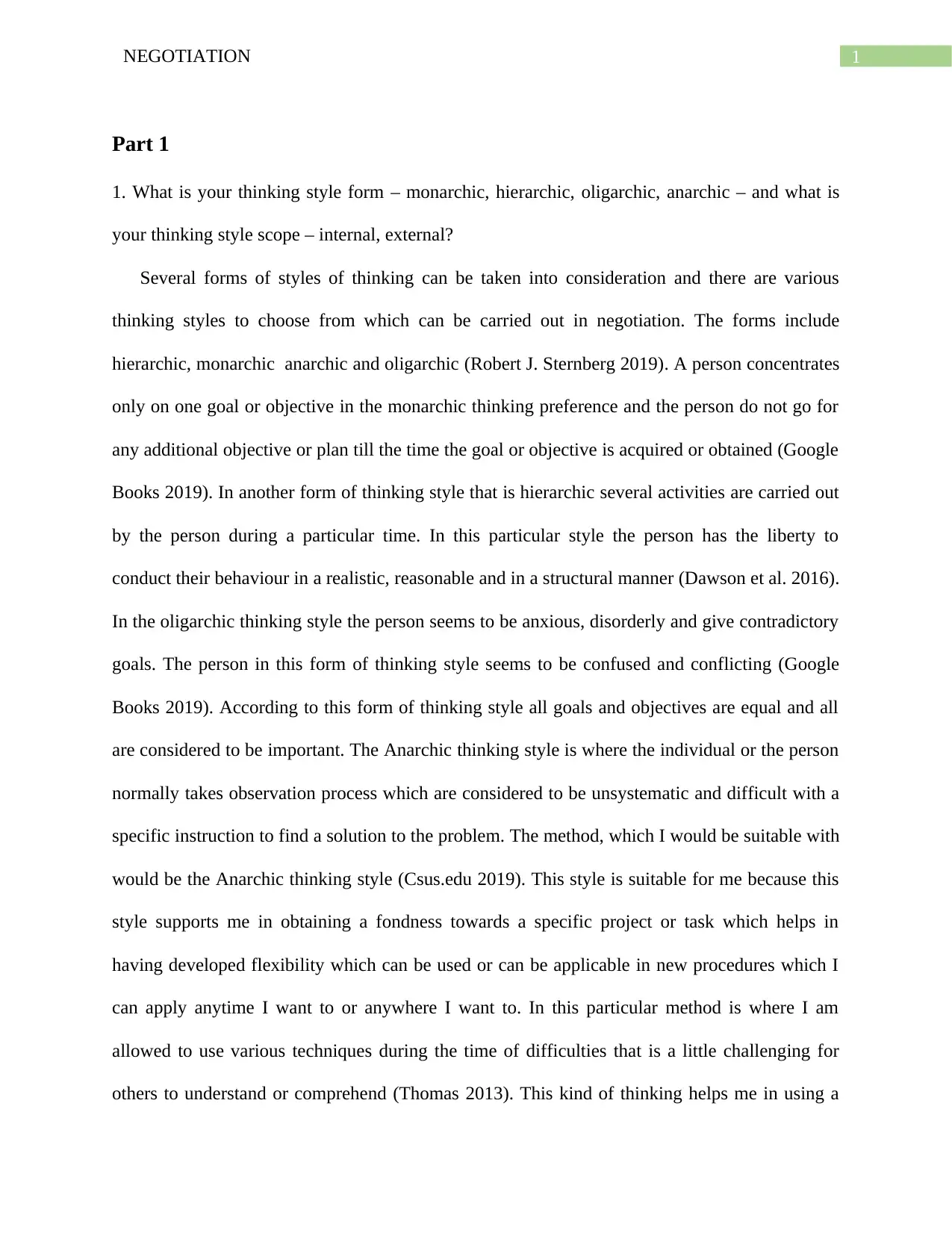
1NEGOTIATION
Part 1
1. What is your thinking style form – monarchic, hierarchic, oligarchic, anarchic – and what is
your thinking style scope – internal, external?
Several forms of styles of thinking can be taken into consideration and there are various
thinking styles to choose from which can be carried out in negotiation. The forms include
hierarchic, monarchic anarchic and oligarchic (Robert J. Sternberg 2019). A person concentrates
only on one goal or objective in the monarchic thinking preference and the person do not go for
any additional objective or plan till the time the goal or objective is acquired or obtained (Google
Books 2019). In another form of thinking style that is hierarchic several activities are carried out
by the person during a particular time. In this particular style the person has the liberty to
conduct their behaviour in a realistic, reasonable and in a structural manner (Dawson et al. 2016).
In the oligarchic thinking style the person seems to be anxious, disorderly and give contradictory
goals. The person in this form of thinking style seems to be confused and conflicting (Google
Books 2019). According to this form of thinking style all goals and objectives are equal and all
are considered to be important. The Anarchic thinking style is where the individual or the person
normally takes observation process which are considered to be unsystematic and difficult with a
specific instruction to find a solution to the problem. The method, which I would be suitable with
would be the Anarchic thinking style (Csus.edu 2019). This style is suitable for me because this
style supports me in obtaining a fondness towards a specific project or task which helps in
having developed flexibility which can be used or can be applicable in new procedures which I
can apply anytime I want to or anywhere I want to. In this particular method is where I am
allowed to use various techniques during the time of difficulties that is a little challenging for
others to understand or comprehend (Thomas 2013). This kind of thinking helps me in using a
Part 1
1. What is your thinking style form – monarchic, hierarchic, oligarchic, anarchic – and what is
your thinking style scope – internal, external?
Several forms of styles of thinking can be taken into consideration and there are various
thinking styles to choose from which can be carried out in negotiation. The forms include
hierarchic, monarchic anarchic and oligarchic (Robert J. Sternberg 2019). A person concentrates
only on one goal or objective in the monarchic thinking preference and the person do not go for
any additional objective or plan till the time the goal or objective is acquired or obtained (Google
Books 2019). In another form of thinking style that is hierarchic several activities are carried out
by the person during a particular time. In this particular style the person has the liberty to
conduct their behaviour in a realistic, reasonable and in a structural manner (Dawson et al. 2016).
In the oligarchic thinking style the person seems to be anxious, disorderly and give contradictory
goals. The person in this form of thinking style seems to be confused and conflicting (Google
Books 2019). According to this form of thinking style all goals and objectives are equal and all
are considered to be important. The Anarchic thinking style is where the individual or the person
normally takes observation process which are considered to be unsystematic and difficult with a
specific instruction to find a solution to the problem. The method, which I would be suitable with
would be the Anarchic thinking style (Csus.edu 2019). This style is suitable for me because this
style supports me in obtaining a fondness towards a specific project or task which helps in
having developed flexibility which can be used or can be applicable in new procedures which I
can apply anytime I want to or anywhere I want to. In this particular method is where I am
allowed to use various techniques during the time of difficulties that is a little challenging for
others to understand or comprehend (Thomas 2013). This kind of thinking helps me in using a
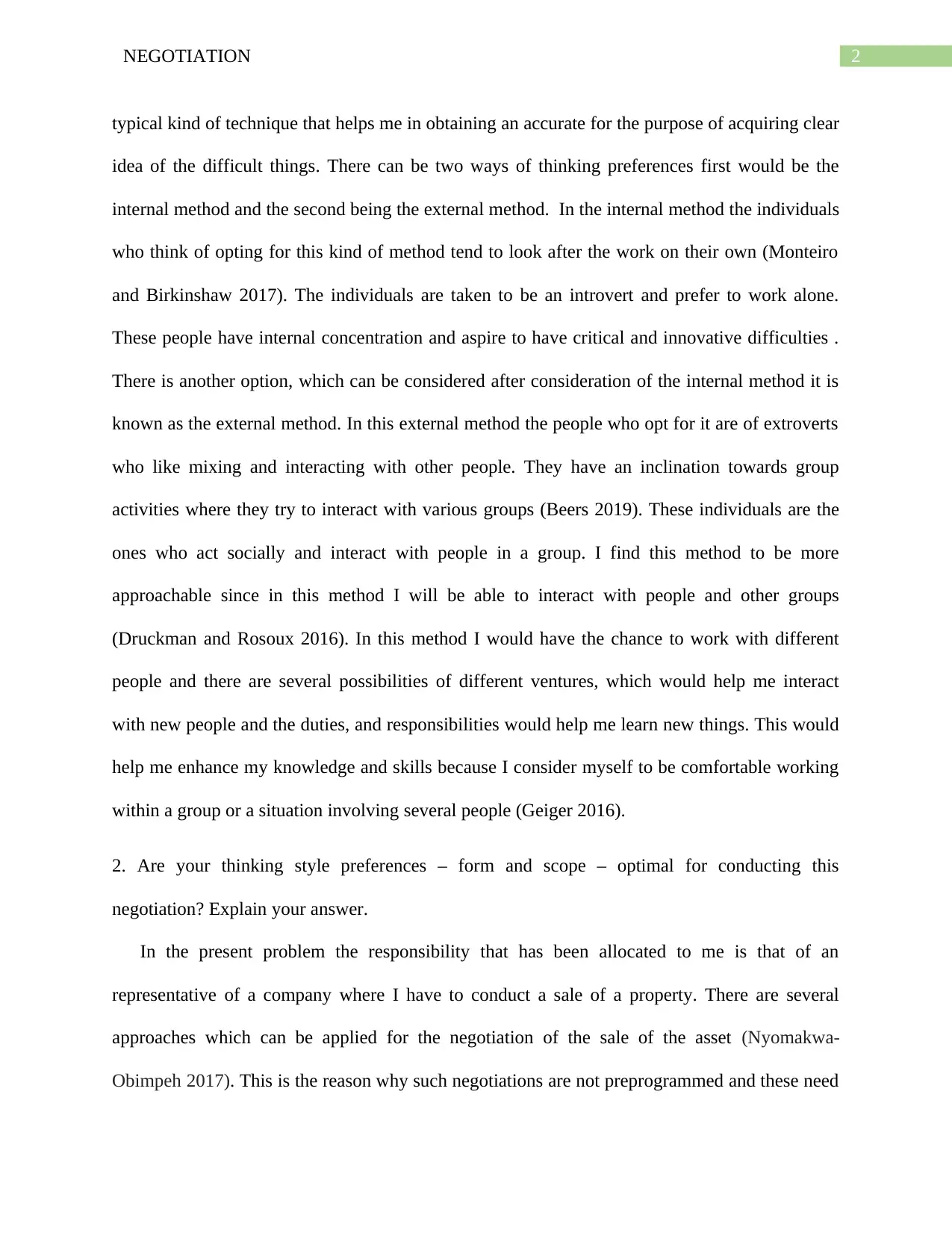
2NEGOTIATION
typical kind of technique that helps me in obtaining an accurate for the purpose of acquiring clear
idea of the difficult things. There can be two ways of thinking preferences first would be the
internal method and the second being the external method. In the internal method the individuals
who think of opting for this kind of method tend to look after the work on their own (Monteiro
and Birkinshaw 2017). The individuals are taken to be an introvert and prefer to work alone.
These people have internal concentration and aspire to have critical and innovative difficulties .
There is another option, which can be considered after consideration of the internal method it is
known as the external method. In this external method the people who opt for it are of extroverts
who like mixing and interacting with other people. They have an inclination towards group
activities where they try to interact with various groups (Beers 2019). These individuals are the
ones who act socially and interact with people in a group. I find this method to be more
approachable since in this method I will be able to interact with people and other groups
(Druckman and Rosoux 2016). In this method I would have the chance to work with different
people and there are several possibilities of different ventures, which would help me interact
with new people and the duties, and responsibilities would help me learn new things. This would
help me enhance my knowledge and skills because I consider myself to be comfortable working
within a group or a situation involving several people (Geiger 2016).
2. Are your thinking style preferences – form and scope – optimal for conducting this
negotiation? Explain your answer.
In the present problem the responsibility that has been allocated to me is that of an
representative of a company where I have to conduct a sale of a property. There are several
approaches which can be applied for the negotiation of the sale of the asset (Nyomakwa-
Obimpeh 2017). This is the reason why such negotiations are not preprogrammed and these need
typical kind of technique that helps me in obtaining an accurate for the purpose of acquiring clear
idea of the difficult things. There can be two ways of thinking preferences first would be the
internal method and the second being the external method. In the internal method the individuals
who think of opting for this kind of method tend to look after the work on their own (Monteiro
and Birkinshaw 2017). The individuals are taken to be an introvert and prefer to work alone.
These people have internal concentration and aspire to have critical and innovative difficulties .
There is another option, which can be considered after consideration of the internal method it is
known as the external method. In this external method the people who opt for it are of extroverts
who like mixing and interacting with other people. They have an inclination towards group
activities where they try to interact with various groups (Beers 2019). These individuals are the
ones who act socially and interact with people in a group. I find this method to be more
approachable since in this method I will be able to interact with people and other groups
(Druckman and Rosoux 2016). In this method I would have the chance to work with different
people and there are several possibilities of different ventures, which would help me interact
with new people and the duties, and responsibilities would help me learn new things. This would
help me enhance my knowledge and skills because I consider myself to be comfortable working
within a group or a situation involving several people (Geiger 2016).
2. Are your thinking style preferences – form and scope – optimal for conducting this
negotiation? Explain your answer.
In the present problem the responsibility that has been allocated to me is that of an
representative of a company where I have to conduct a sale of a property. There are several
approaches which can be applied for the negotiation of the sale of the asset (Nyomakwa-
Obimpeh 2017). This is the reason why such negotiations are not preprogrammed and these need
⊘ This is a preview!⊘
Do you want full access?
Subscribe today to unlock all pages.

Trusted by 1+ million students worldwide
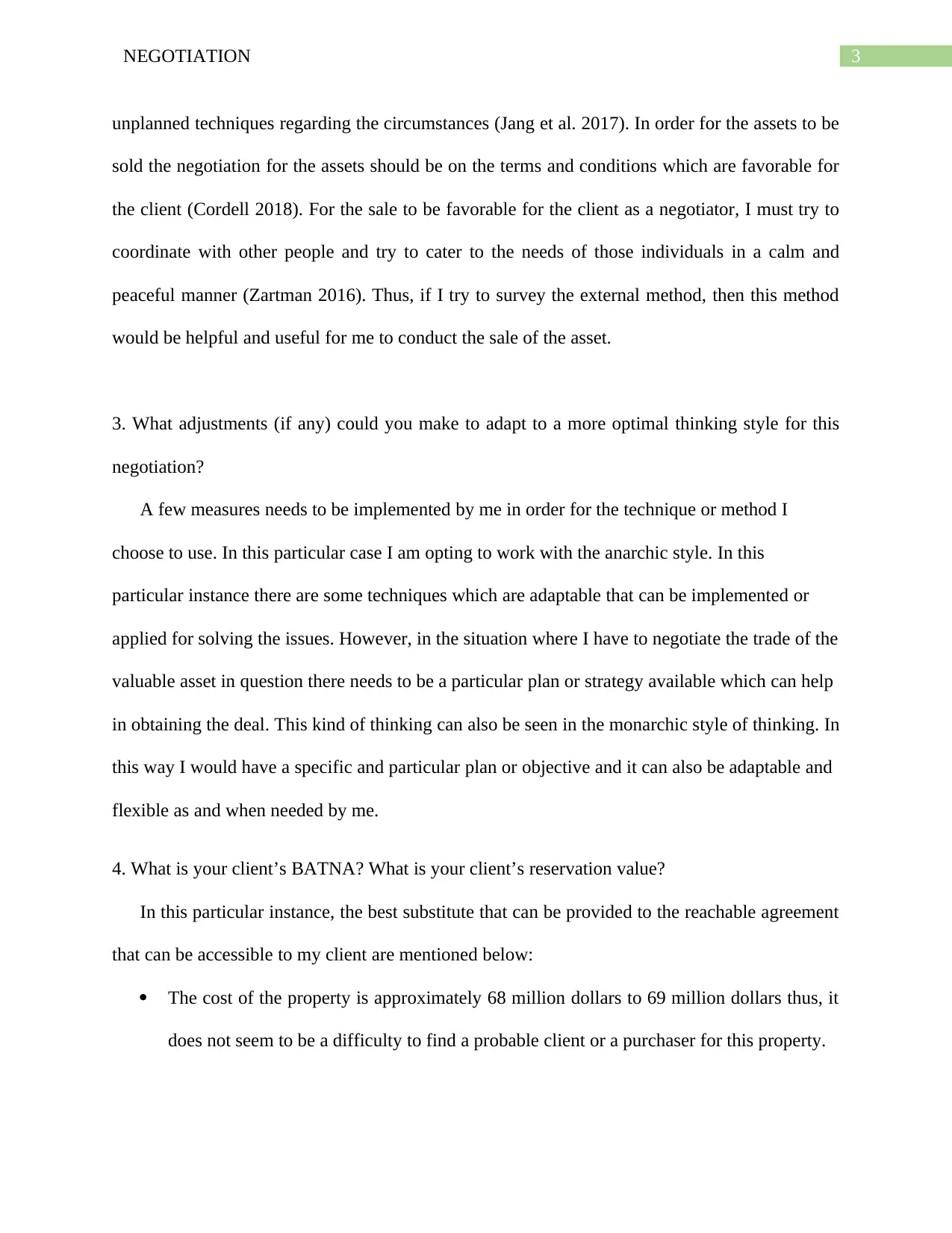
3NEGOTIATION
unplanned techniques regarding the circumstances (Jang et al. 2017). In order for the assets to be
sold the negotiation for the assets should be on the terms and conditions which are favorable for
the client (Cordell 2018). For the sale to be favorable for the client as a negotiator, I must try to
coordinate with other people and try to cater to the needs of those individuals in a calm and
peaceful manner (Zartman 2016). Thus, if I try to survey the external method, then this method
would be helpful and useful for me to conduct the sale of the asset.
3. What adjustments (if any) could you make to adapt to a more optimal thinking style for this
negotiation?
A few measures needs to be implemented by me in order for the technique or method I
choose to use. In this particular case I am opting to work with the anarchic style. In this
particular instance there are some techniques which are adaptable that can be implemented or
applied for solving the issues. However, in the situation where I have to negotiate the trade of the
valuable asset in question there needs to be a particular plan or strategy available which can help
in obtaining the deal. This kind of thinking can also be seen in the monarchic style of thinking. In
this way I would have a specific and particular plan or objective and it can also be adaptable and
flexible as and when needed by me.
4. What is your client’s BATNA? What is your client’s reservation value?
In this particular instance, the best substitute that can be provided to the reachable agreement
that can be accessible to my client are mentioned below:
The cost of the property is approximately 68 million dollars to 69 million dollars thus, it
does not seem to be a difficulty to find a probable client or a purchaser for this property.
unplanned techniques regarding the circumstances (Jang et al. 2017). In order for the assets to be
sold the negotiation for the assets should be on the terms and conditions which are favorable for
the client (Cordell 2018). For the sale to be favorable for the client as a negotiator, I must try to
coordinate with other people and try to cater to the needs of those individuals in a calm and
peaceful manner (Zartman 2016). Thus, if I try to survey the external method, then this method
would be helpful and useful for me to conduct the sale of the asset.
3. What adjustments (if any) could you make to adapt to a more optimal thinking style for this
negotiation?
A few measures needs to be implemented by me in order for the technique or method I
choose to use. In this particular case I am opting to work with the anarchic style. In this
particular instance there are some techniques which are adaptable that can be implemented or
applied for solving the issues. However, in the situation where I have to negotiate the trade of the
valuable asset in question there needs to be a particular plan or strategy available which can help
in obtaining the deal. This kind of thinking can also be seen in the monarchic style of thinking. In
this way I would have a specific and particular plan or objective and it can also be adaptable and
flexible as and when needed by me.
4. What is your client’s BATNA? What is your client’s reservation value?
In this particular instance, the best substitute that can be provided to the reachable agreement
that can be accessible to my client are mentioned below:
The cost of the property is approximately 68 million dollars to 69 million dollars thus, it
does not seem to be a difficulty to find a probable client or a purchaser for this property.
Paraphrase This Document
Need a fresh take? Get an instant paraphrase of this document with our AI Paraphraser
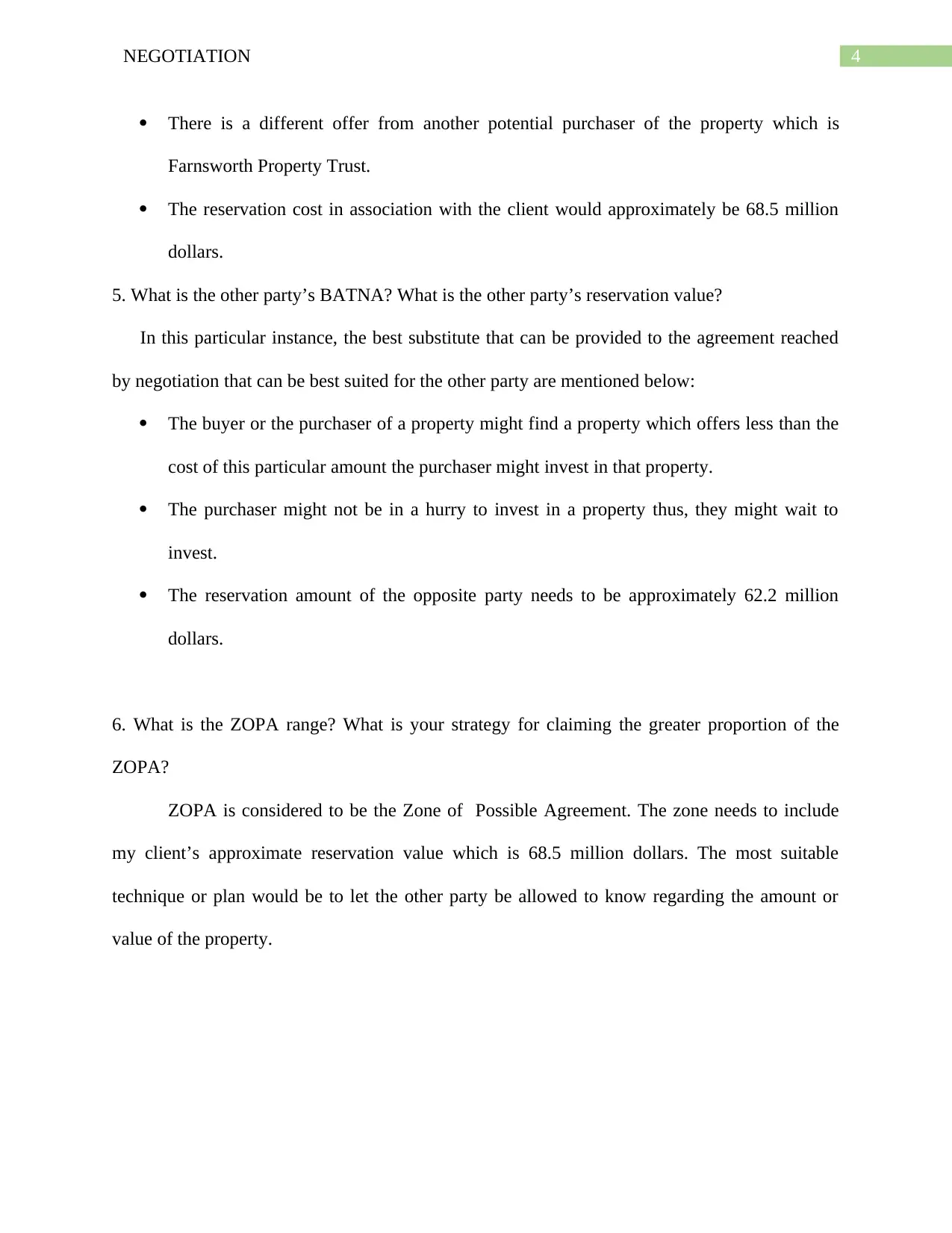
4NEGOTIATION
There is a different offer from another potential purchaser of the property which is
Farnsworth Property Trust.
The reservation cost in association with the client would approximately be 68.5 million
dollars.
5. What is the other party’s BATNA? What is the other party’s reservation value?
In this particular instance, the best substitute that can be provided to the agreement reached
by negotiation that can be best suited for the other party are mentioned below:
The buyer or the purchaser of a property might find a property which offers less than the
cost of this particular amount the purchaser might invest in that property.
The purchaser might not be in a hurry to invest in a property thus, they might wait to
invest.
The reservation amount of the opposite party needs to be approximately 62.2 million
dollars.
6. What is the ZOPA range? What is your strategy for claiming the greater proportion of the
ZOPA?
ZOPA is considered to be the Zone of Possible Agreement. The zone needs to include
my client’s approximate reservation value which is 68.5 million dollars. The most suitable
technique or plan would be to let the other party be allowed to know regarding the amount or
value of the property.
There is a different offer from another potential purchaser of the property which is
Farnsworth Property Trust.
The reservation cost in association with the client would approximately be 68.5 million
dollars.
5. What is the other party’s BATNA? What is the other party’s reservation value?
In this particular instance, the best substitute that can be provided to the agreement reached
by negotiation that can be best suited for the other party are mentioned below:
The buyer or the purchaser of a property might find a property which offers less than the
cost of this particular amount the purchaser might invest in that property.
The purchaser might not be in a hurry to invest in a property thus, they might wait to
invest.
The reservation amount of the opposite party needs to be approximately 62.2 million
dollars.
6. What is the ZOPA range? What is your strategy for claiming the greater proportion of the
ZOPA?
ZOPA is considered to be the Zone of Possible Agreement. The zone needs to include
my client’s approximate reservation value which is 68.5 million dollars. The most suitable
technique or plan would be to let the other party be allowed to know regarding the amount or
value of the property.
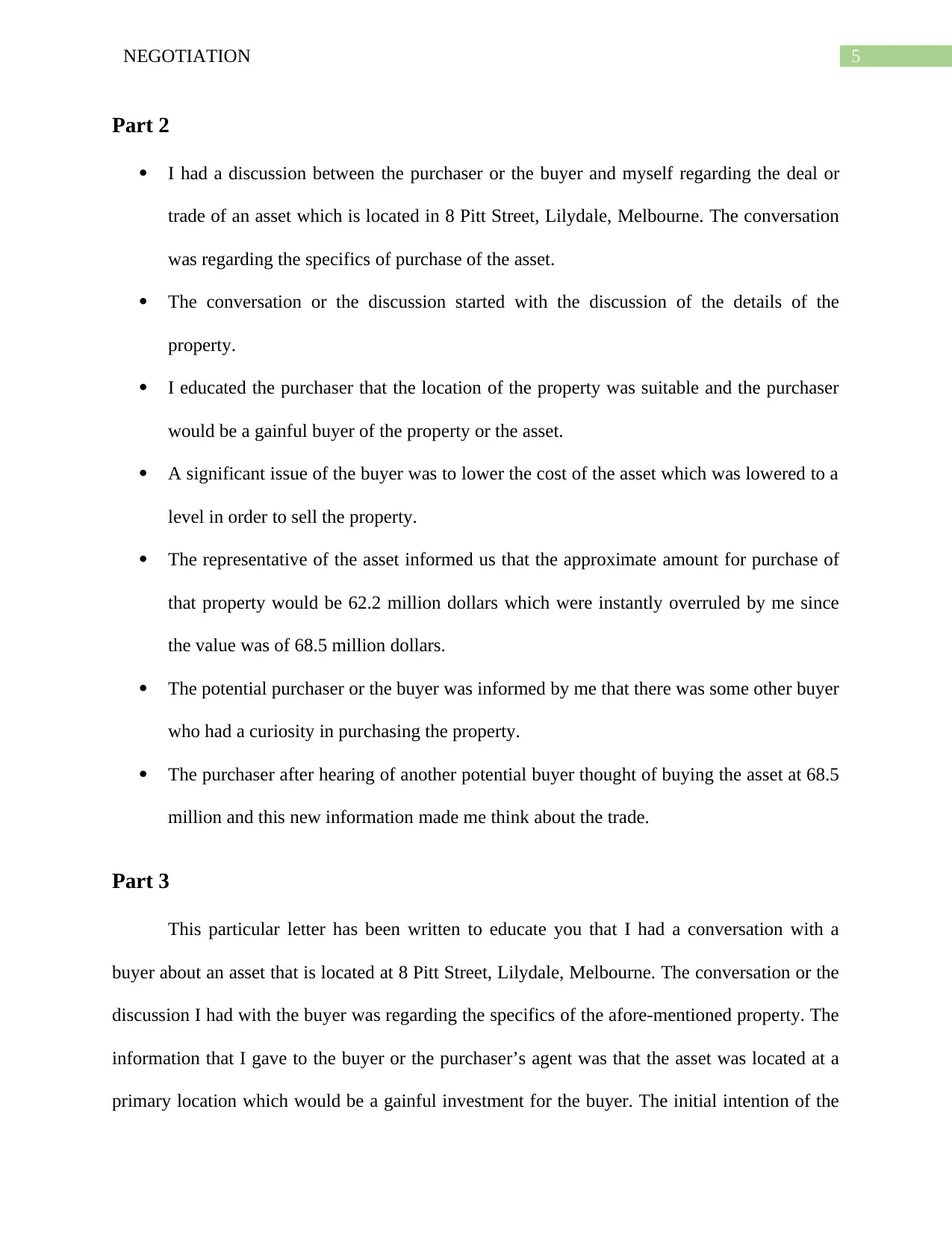
5NEGOTIATION
Part 2
I had a discussion between the purchaser or the buyer and myself regarding the deal or
trade of an asset which is located in 8 Pitt Street, Lilydale, Melbourne. The conversation
was regarding the specifics of purchase of the asset.
The conversation or the discussion started with the discussion of the details of the
property.
I educated the purchaser that the location of the property was suitable and the purchaser
would be a gainful buyer of the property or the asset.
A significant issue of the buyer was to lower the cost of the asset which was lowered to a
level in order to sell the property.
The representative of the asset informed us that the approximate amount for purchase of
that property would be 62.2 million dollars which were instantly overruled by me since
the value was of 68.5 million dollars.
The potential purchaser or the buyer was informed by me that there was some other buyer
who had a curiosity in purchasing the property.
The purchaser after hearing of another potential buyer thought of buying the asset at 68.5
million and this new information made me think about the trade.
Part 3
This particular letter has been written to educate you that I had a conversation with a
buyer about an asset that is located at 8 Pitt Street, Lilydale, Melbourne. The conversation or the
discussion I had with the buyer was regarding the specifics of the afore-mentioned property. The
information that I gave to the buyer or the purchaser’s agent was that the asset was located at a
primary location which would be a gainful investment for the buyer. The initial intention of the
Part 2
I had a discussion between the purchaser or the buyer and myself regarding the deal or
trade of an asset which is located in 8 Pitt Street, Lilydale, Melbourne. The conversation
was regarding the specifics of purchase of the asset.
The conversation or the discussion started with the discussion of the details of the
property.
I educated the purchaser that the location of the property was suitable and the purchaser
would be a gainful buyer of the property or the asset.
A significant issue of the buyer was to lower the cost of the asset which was lowered to a
level in order to sell the property.
The representative of the asset informed us that the approximate amount for purchase of
that property would be 62.2 million dollars which were instantly overruled by me since
the value was of 68.5 million dollars.
The potential purchaser or the buyer was informed by me that there was some other buyer
who had a curiosity in purchasing the property.
The purchaser after hearing of another potential buyer thought of buying the asset at 68.5
million and this new information made me think about the trade.
Part 3
This particular letter has been written to educate you that I had a conversation with a
buyer about an asset that is located at 8 Pitt Street, Lilydale, Melbourne. The conversation or the
discussion I had with the buyer was regarding the specifics of the afore-mentioned property. The
information that I gave to the buyer or the purchaser’s agent was that the asset was located at a
primary location which would be a gainful investment for the buyer. The initial intention of the
⊘ This is a preview!⊘
Do you want full access?
Subscribe today to unlock all pages.

Trusted by 1+ million students worldwide
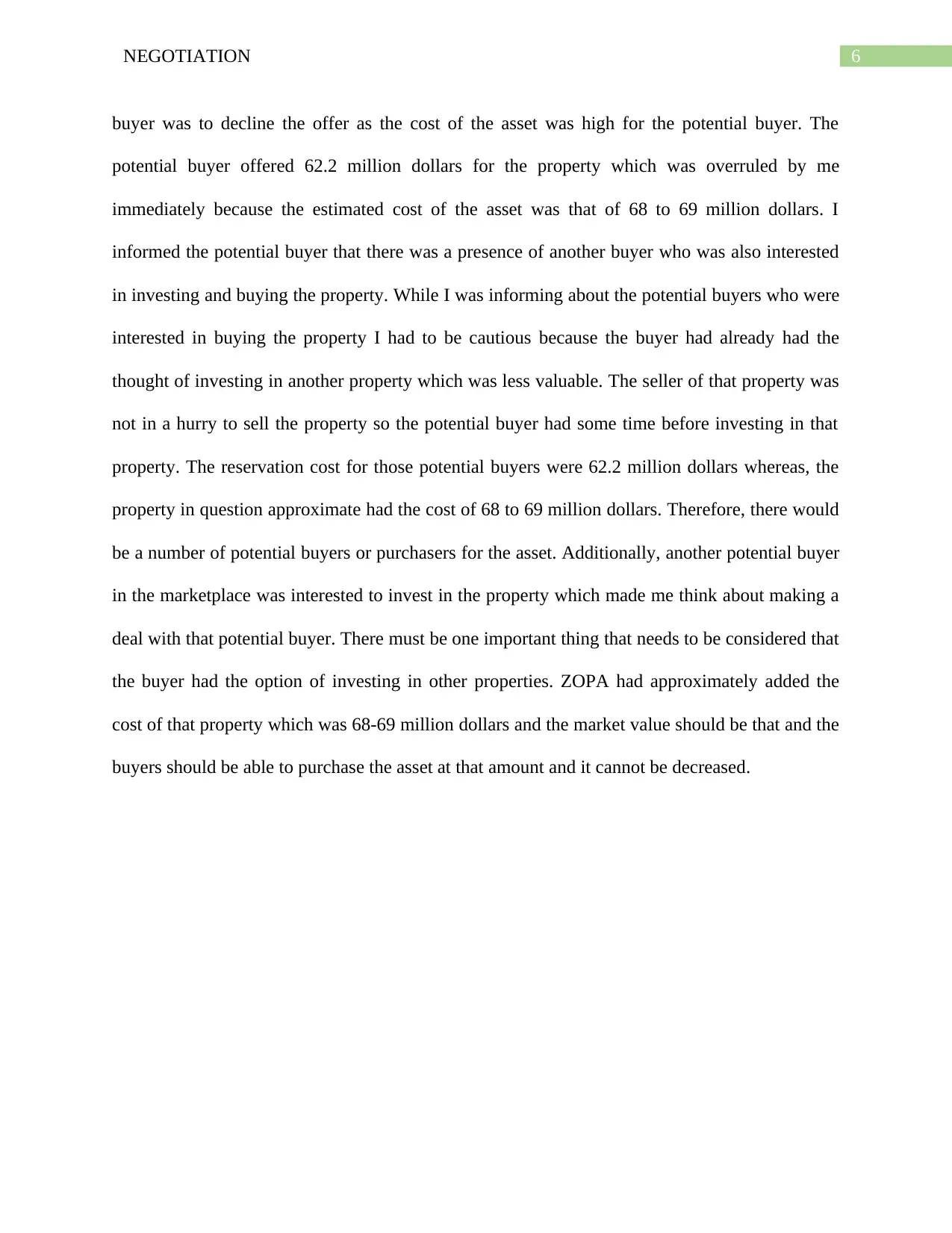
6NEGOTIATION
buyer was to decline the offer as the cost of the asset was high for the potential buyer. The
potential buyer offered 62.2 million dollars for the property which was overruled by me
immediately because the estimated cost of the asset was that of 68 to 69 million dollars. I
informed the potential buyer that there was a presence of another buyer who was also interested
in investing and buying the property. While I was informing about the potential buyers who were
interested in buying the property I had to be cautious because the buyer had already had the
thought of investing in another property which was less valuable. The seller of that property was
not in a hurry to sell the property so the potential buyer had some time before investing in that
property. The reservation cost for those potential buyers were 62.2 million dollars whereas, the
property in question approximate had the cost of 68 to 69 million dollars. Therefore, there would
be a number of potential buyers or purchasers for the asset. Additionally, another potential buyer
in the marketplace was interested to invest in the property which made me think about making a
deal with that potential buyer. There must be one important thing that needs to be considered that
the buyer had the option of investing in other properties. ZOPA had approximately added the
cost of that property which was 68-69 million dollars and the market value should be that and the
buyers should be able to purchase the asset at that amount and it cannot be decreased.
buyer was to decline the offer as the cost of the asset was high for the potential buyer. The
potential buyer offered 62.2 million dollars for the property which was overruled by me
immediately because the estimated cost of the asset was that of 68 to 69 million dollars. I
informed the potential buyer that there was a presence of another buyer who was also interested
in investing and buying the property. While I was informing about the potential buyers who were
interested in buying the property I had to be cautious because the buyer had already had the
thought of investing in another property which was less valuable. The seller of that property was
not in a hurry to sell the property so the potential buyer had some time before investing in that
property. The reservation cost for those potential buyers were 62.2 million dollars whereas, the
property in question approximate had the cost of 68 to 69 million dollars. Therefore, there would
be a number of potential buyers or purchasers for the asset. Additionally, another potential buyer
in the marketplace was interested to invest in the property which made me think about making a
deal with that potential buyer. There must be one important thing that needs to be considered that
the buyer had the option of investing in other properties. ZOPA had approximately added the
cost of that property which was 68-69 million dollars and the market value should be that and the
buyers should be able to purchase the asset at that amount and it cannot be decreased.
Paraphrase This Document
Need a fresh take? Get an instant paraphrase of this document with our AI Paraphraser
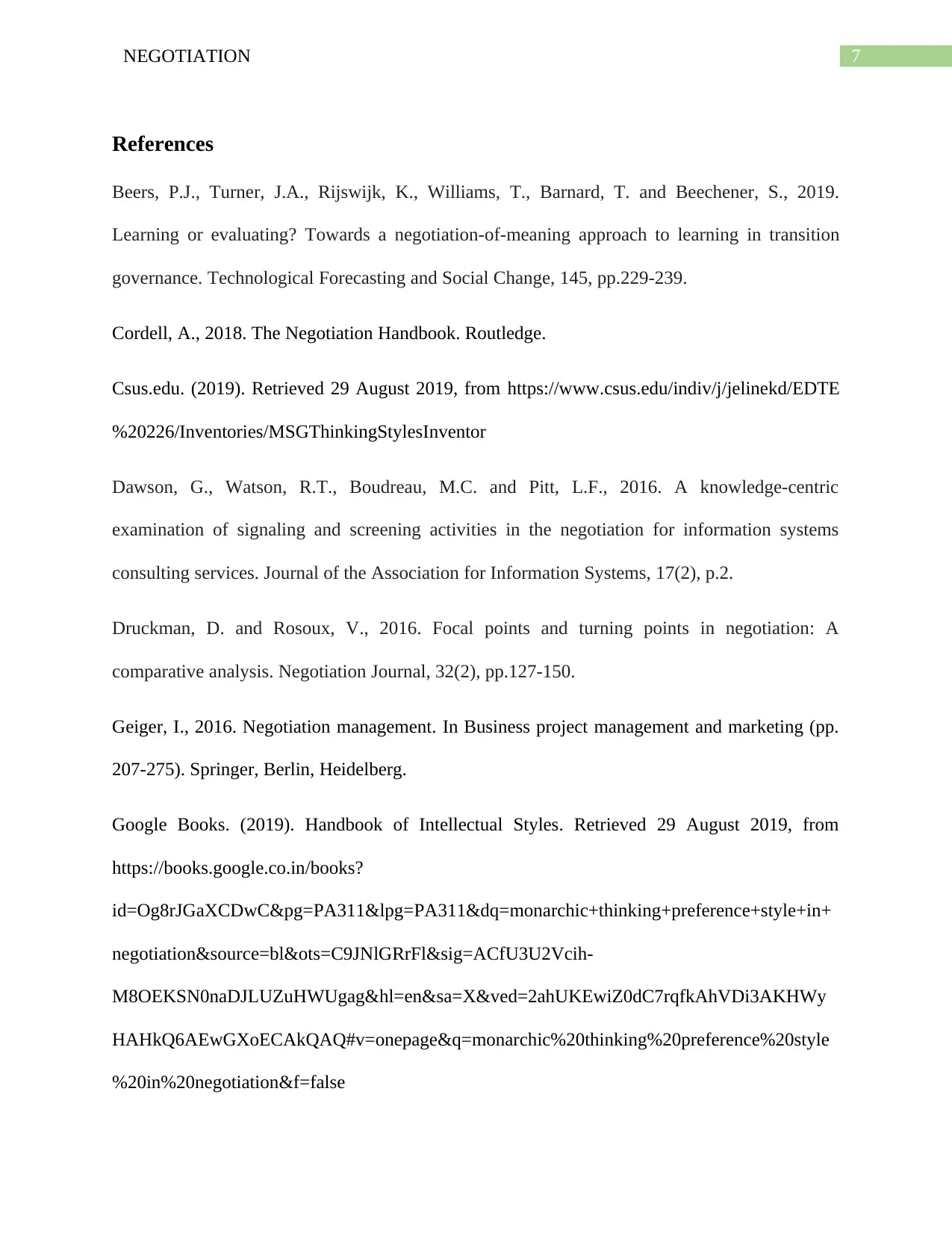
7NEGOTIATION
References
Beers, P.J., Turner, J.A., Rijswijk, K., Williams, T., Barnard, T. and Beechener, S., 2019.
Learning or evaluating? Towards a negotiation-of-meaning approach to learning in transition
governance. Technological Forecasting and Social Change, 145, pp.229-239.
Cordell, A., 2018. The Negotiation Handbook. Routledge.
Csus.edu. (2019). Retrieved 29 August 2019, from https://www.csus.edu/indiv/j/jelinekd/EDTE
%20226/Inventories/MSGThinkingStylesInventor
Dawson, G., Watson, R.T., Boudreau, M.C. and Pitt, L.F., 2016. A knowledge-centric
examination of signaling and screening activities in the negotiation for information systems
consulting services. Journal of the Association for Information Systems, 17(2), p.2.
Druckman, D. and Rosoux, V., 2016. Focal points and turning points in negotiation: A
comparative analysis. Negotiation Journal, 32(2), pp.127-150.
Geiger, I., 2016. Negotiation management. In Business project management and marketing (pp.
207-275). Springer, Berlin, Heidelberg.
Google Books. (2019). Handbook of Intellectual Styles. Retrieved 29 August 2019, from
https://books.google.co.in/books?
id=Og8rJGaXCDwC&pg=PA311&lpg=PA311&dq=monarchic+thinking+preference+style+in+
negotiation&source=bl&ots=C9JNlGRrFl&sig=ACfU3U2Vcih-
M8OEKSN0naDJLUZuHWUgag&hl=en&sa=X&ved=2ahUKEwiZ0dC7rqfkAhVDi3AKHWy
HAHkQ6AEwGXoECAkQAQ#v=onepage&q=monarchic%20thinking%20preference%20style
%20in%20negotiation&f=false
References
Beers, P.J., Turner, J.A., Rijswijk, K., Williams, T., Barnard, T. and Beechener, S., 2019.
Learning or evaluating? Towards a negotiation-of-meaning approach to learning in transition
governance. Technological Forecasting and Social Change, 145, pp.229-239.
Cordell, A., 2018. The Negotiation Handbook. Routledge.
Csus.edu. (2019). Retrieved 29 August 2019, from https://www.csus.edu/indiv/j/jelinekd/EDTE
%20226/Inventories/MSGThinkingStylesInventor
Dawson, G., Watson, R.T., Boudreau, M.C. and Pitt, L.F., 2016. A knowledge-centric
examination of signaling and screening activities in the negotiation for information systems
consulting services. Journal of the Association for Information Systems, 17(2), p.2.
Druckman, D. and Rosoux, V., 2016. Focal points and turning points in negotiation: A
comparative analysis. Negotiation Journal, 32(2), pp.127-150.
Geiger, I., 2016. Negotiation management. In Business project management and marketing (pp.
207-275). Springer, Berlin, Heidelberg.
Google Books. (2019). Handbook of Intellectual Styles. Retrieved 29 August 2019, from
https://books.google.co.in/books?
id=Og8rJGaXCDwC&pg=PA311&lpg=PA311&dq=monarchic+thinking+preference+style+in+
negotiation&source=bl&ots=C9JNlGRrFl&sig=ACfU3U2Vcih-
M8OEKSN0naDJLUZuHWUgag&hl=en&sa=X&ved=2ahUKEwiZ0dC7rqfkAhVDi3AKHWy
HAHkQ6AEwGXoECAkQAQ#v=onepage&q=monarchic%20thinking%20preference%20style
%20in%20negotiation&f=false
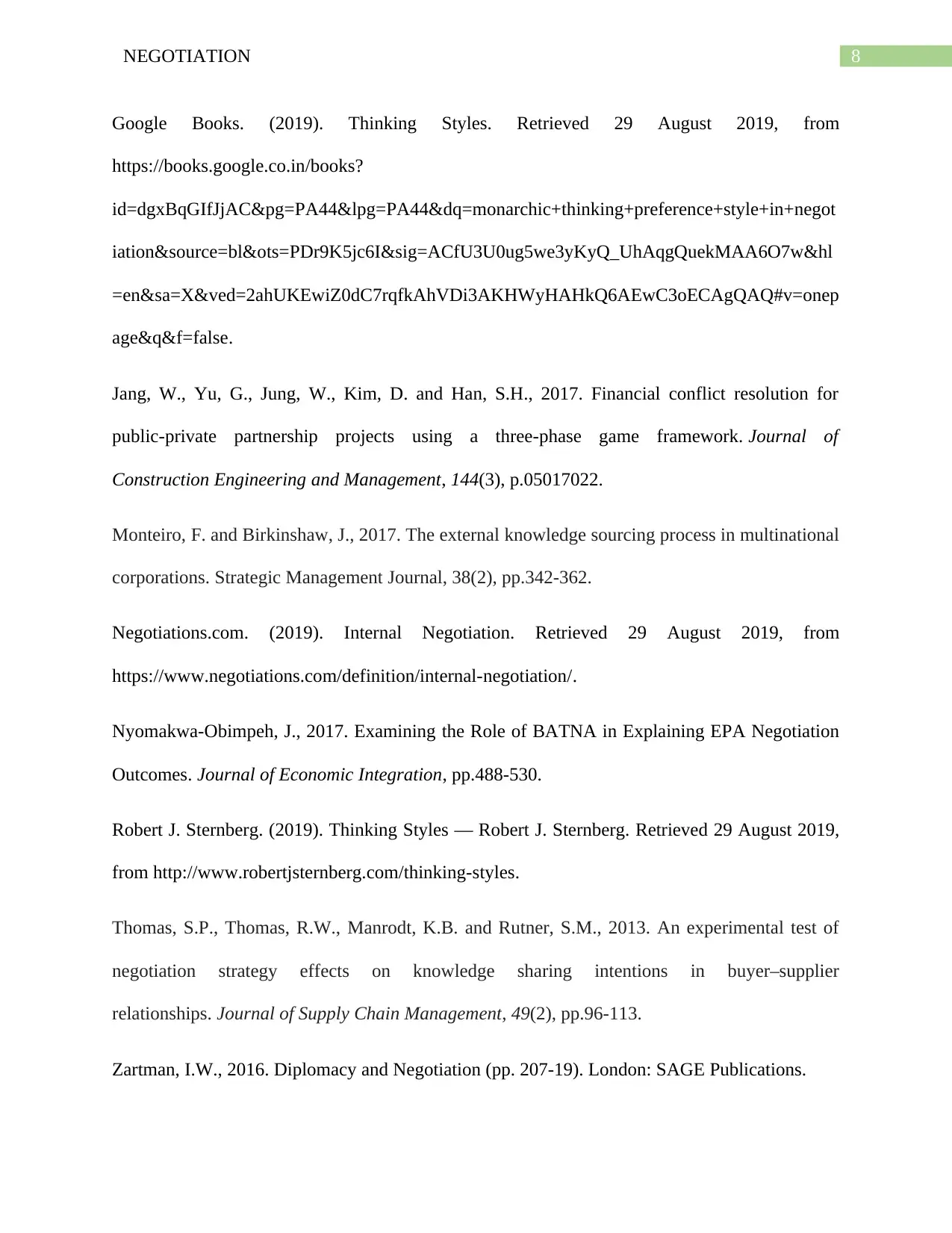
8NEGOTIATION
Google Books. (2019). Thinking Styles. Retrieved 29 August 2019, from
https://books.google.co.in/books?
id=dgxBqGIfJjAC&pg=PA44&lpg=PA44&dq=monarchic+thinking+preference+style+in+negot
iation&source=bl&ots=PDr9K5jc6I&sig=ACfU3U0ug5we3yKyQ_UhAqgQuekMAA6O7w&hl
=en&sa=X&ved=2ahUKEwiZ0dC7rqfkAhVDi3AKHWyHAHkQ6AEwC3oECAgQAQ#v=onep
age&q&f=false.
Jang, W., Yu, G., Jung, W., Kim, D. and Han, S.H., 2017. Financial conflict resolution for
public-private partnership projects using a three-phase game framework. Journal of
Construction Engineering and Management, 144(3), p.05017022.
Monteiro, F. and Birkinshaw, J., 2017. The external knowledge sourcing process in multinational
corporations. Strategic Management Journal, 38(2), pp.342-362.
Negotiations.com. (2019). Internal Negotiation. Retrieved 29 August 2019, from
https://www.negotiations.com/definition/internal-negotiation/.
Nyomakwa-Obimpeh, J., 2017. Examining the Role of BATNA in Explaining EPA Negotiation
Outcomes. Journal of Economic Integration, pp.488-530.
Robert J. Sternberg. (2019). Thinking Styles — Robert J. Sternberg. Retrieved 29 August 2019,
from http://www.robertjsternberg.com/thinking-styles.
Thomas, S.P., Thomas, R.W., Manrodt, K.B. and Rutner, S.M., 2013. An experimental test of
negotiation strategy effects on knowledge sharing intentions in buyer–supplier
relationships. Journal of Supply Chain Management, 49(2), pp.96-113.
Zartman, I.W., 2016. Diplomacy and Negotiation (pp. 207-19). London: SAGE Publications.
Google Books. (2019). Thinking Styles. Retrieved 29 August 2019, from
https://books.google.co.in/books?
id=dgxBqGIfJjAC&pg=PA44&lpg=PA44&dq=monarchic+thinking+preference+style+in+negot
iation&source=bl&ots=PDr9K5jc6I&sig=ACfU3U0ug5we3yKyQ_UhAqgQuekMAA6O7w&hl
=en&sa=X&ved=2ahUKEwiZ0dC7rqfkAhVDi3AKHWyHAHkQ6AEwC3oECAgQAQ#v=onep
age&q&f=false.
Jang, W., Yu, G., Jung, W., Kim, D. and Han, S.H., 2017. Financial conflict resolution for
public-private partnership projects using a three-phase game framework. Journal of
Construction Engineering and Management, 144(3), p.05017022.
Monteiro, F. and Birkinshaw, J., 2017. The external knowledge sourcing process in multinational
corporations. Strategic Management Journal, 38(2), pp.342-362.
Negotiations.com. (2019). Internal Negotiation. Retrieved 29 August 2019, from
https://www.negotiations.com/definition/internal-negotiation/.
Nyomakwa-Obimpeh, J., 2017. Examining the Role of BATNA in Explaining EPA Negotiation
Outcomes. Journal of Economic Integration, pp.488-530.
Robert J. Sternberg. (2019). Thinking Styles — Robert J. Sternberg. Retrieved 29 August 2019,
from http://www.robertjsternberg.com/thinking-styles.
Thomas, S.P., Thomas, R.W., Manrodt, K.B. and Rutner, S.M., 2013. An experimental test of
negotiation strategy effects on knowledge sharing intentions in buyer–supplier
relationships. Journal of Supply Chain Management, 49(2), pp.96-113.
Zartman, I.W., 2016. Diplomacy and Negotiation (pp. 207-19). London: SAGE Publications.
⊘ This is a preview!⊘
Do you want full access?
Subscribe today to unlock all pages.

Trusted by 1+ million students worldwide
1 out of 9
Related Documents
Your All-in-One AI-Powered Toolkit for Academic Success.
+13062052269
info@desklib.com
Available 24*7 on WhatsApp / Email
![[object Object]](/_next/static/media/star-bottom.7253800d.svg)
Unlock your academic potential
Copyright © 2020–2025 A2Z Services. All Rights Reserved. Developed and managed by ZUCOL.





